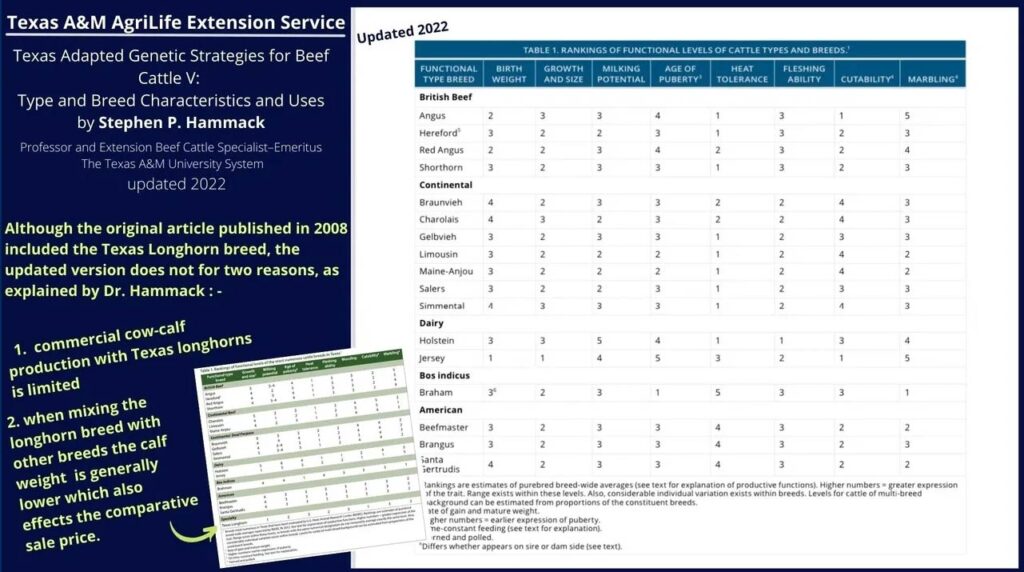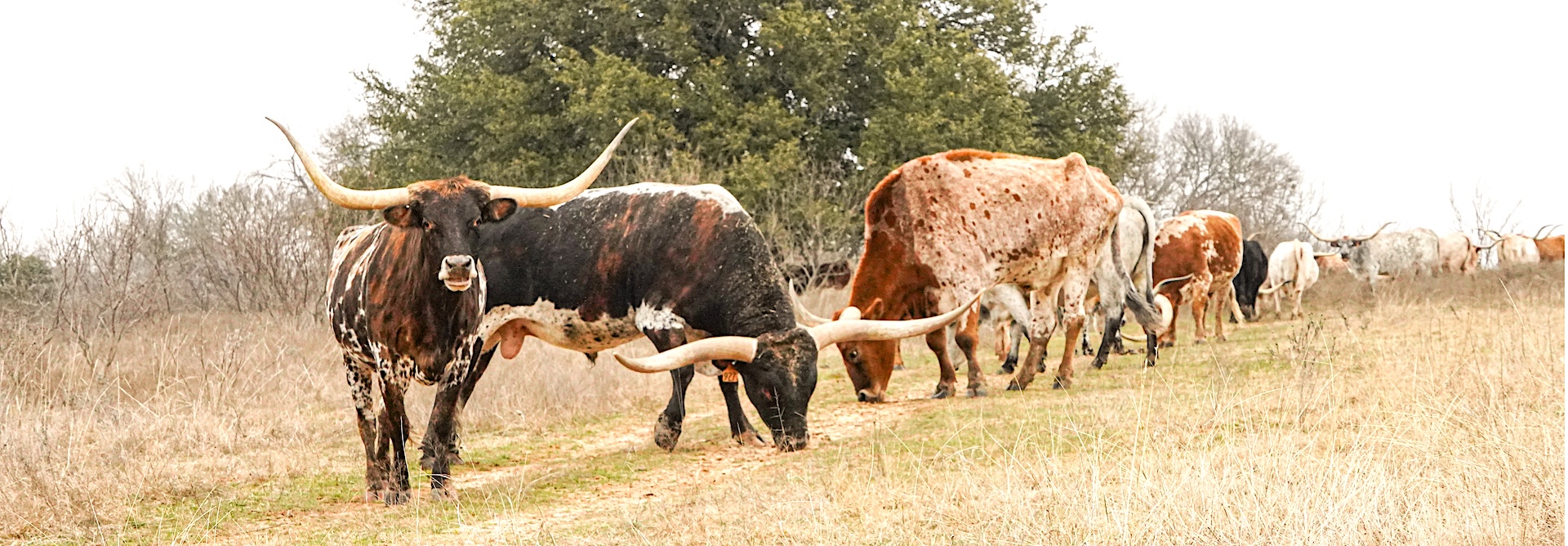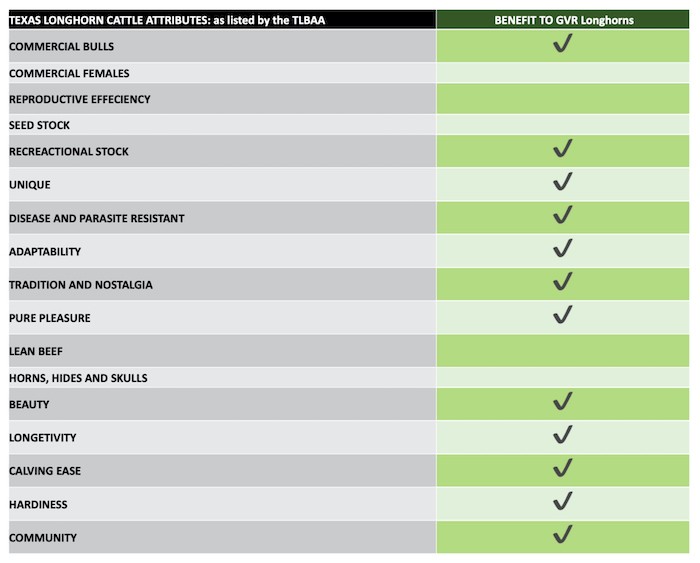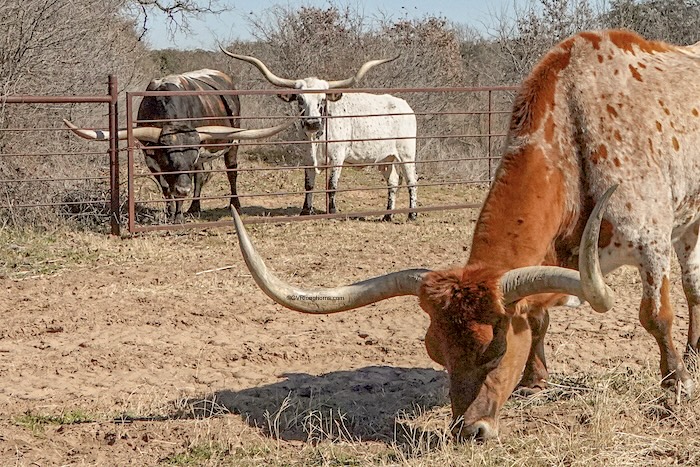The Pros and Cons of Texas Longhorns
We often touch on individual Pros and Cons of Texas Longhorn Cattle. Here is a comprehensive list of what we consider to be the most relevant Pros and Cons with regard to the Texas Longhorns in 2025 in Texas.
The Context in which we assess the Pros and Cons of Texas Longhorn Cattle
- To keep this information current, the USDA beef cattle inventory survey of 2025 is our starting point.
- According to these USDA statistics, cattle numbers in the USA are lower than they were in 2024 by 1%, but higher in Texas by 60,000 head.
- Despite the decrease in the country, A & M AgriLife is cautiously optimistic about the sector in Texas because of the increased number of cattle in the Lone Star State.
- However, even though A & M AgriLife acknowledges higher sales prices for beef cattle, this comes with substantially higher input/ranching costs, and, as always, uncertain climate conditions.
- Nonetheless, raising Texas Longhorns is often less expensive than raising many other breeds of cattle. Therefore, in a scenario where production costs are higher, considering a herd of Texas Longhorns seems like a viable option. In this vein, the TLBAA promotes many market advantages of the Texas Longhorn cattle Breed on their website.
Special Note:-
Our assessment of the Pros and Cons of Texas Longhorns in Texas is based on our own experience and endurance in the Longhorn industry, spanning two decades. Although we personally do not raise our longhorns for beef, the USDA data is a strong indication of the economic climate and the cattle industry as a whole.
Further, it’s important to note that the Texas Longhorn Cattle breed was previously categorized by AgriLife Extension as a “Specialty” beef breed, but was not included in a more recent article published in 2021.(comparative details here) The reasons for the exclusion are twofold, as follows:-
- Commercial calf-cow production with Texas Longhorn Cattle is limited
- Calf weights of Texas Longhorn Cattle are generally lower. This affects the comparison to other breeds.

The Pros and Cons of Texas Longhorns
Why Longhorns?
The Longhorn Breed has gained popularity due to favorable characteristics, which include calving ease, longevity, resistance to disease and parasites, hardiness, climate adaptability, strong maternal instinct, lower cholesterol beef, easy maintenance, and excellent fertility. They are also easy on the eye!

The TLBAA lists 17 attributes that we tabulated and shared from our previous article, 19 Attributes of Texas Longhorn Cattle
Two additional attributes are discussed in more detail in Why Texas Longhorns? Discover the 2 Top Reasons why savvy ranchers choose them. These attributes relate to:-
-
Texas
The Texas Longhorn is unique, iconic, and the State Mammal of the Lone Star State.
-
Agricultural Exemption
In essence, the Texas Longhorn Cattle breed is one of the easiest types of livestock to raise and maintain over time. In Texas, the Texas Longhorn often qualifies for Ag Exemption. With the proper fencing, adequate forage and supplements, as well as water, Texas Longhorns ensure significant savings in property taxes.
Versatility of Texas Longhorns in today’s Cattle market – pros and cons
Texas Longhorns are raised for many reasons. Here is a review of the pros and cons of raising Texas Longhorns depending on your interests.
1. Part-time ranchers and rural acreage owners
Do you dream of escaping the mayhem of city life? Or, perhaps you have acreage. Either way, you are not alone. According to the Texas Land Conservancy, over 95% of land in Texas is privately owned. We know firsthand the sacrifice it takes to fulfill a dream of purchasing and then maintaining acreage. Over 20 years ago, we acquired our first parcel of land in Texas. Initially, we could not afford to live on our acreage, and it took many years of investing in it and manicuring it into what we have today. Back then, Texas Longhorn cattle were the perfect option for us, and here’s why.
- First and foremost, we could maintain our Agricultural Exemption at minimum cost, considering general ranching expenses.
- Texas Longhorn cattle are symbolic in Texas. They are iconic, and we owned them then and still do with a sense of pride.
- Texas Longhorn cattle are easy to maintain as cattle go, especially if they are on their own for periods of time without management. We have raised other breeds of cattle, so we have a comparison.
- In this scenario, here are the pros and cons of owning Texas Longhorn Cattle, as we see it.

PRO’s
- Texas Longhorn Cattle can manage extreme fluctuations in climate.
- They are not fussy eaters. They forage and graze a wider variety of vegetation than many other cattle breeds.
- Texas Longhorn cattle generally have stronger hooves to manage different types of terrain.
- As long as they have enough forage, adequate supplements, water, and good fences, they can generally manage on their own.
- Texas Longhorns are smart. With the essential food and water at their disposal, they can generally fend for themselves.
- Texas Longhorns are truly a hardy breed. They rarely get sick, if ever. They are known for their resistance to disease and parasites. In addition, they can live and reproduce into their twenties.
- They can also fend for themselves and protect their calves. In all the years we have raised longhorns, we have lost one calf to coyotes. That unfortunate incident happened during the extreme weather event of the Arctic Blast of 2021
- The Texas Longhorn Cattle breed is well known for reproductive efficiency and the ability to calve with ease. Therefore, raising longhorns from a distance is less stressful. In fact, we raised our longhorns for a number of years while we lived out of state.
- Costs for Texas Longhorn cattle, such as forage, vet fees, and medical supplies, are generally lower when compared with other cattle breeds. Lower production costs in today’s economic climate are a huge bonus.
- It’s easy to tell Longhorns apart. Each is unique in appearance and personality. This is a huge bonus when tracking age, reproduction, and general health.
- Because Texas Longhorns are easy to maintain compared to many other cattle breeds, previous ranching experience is not essential.
For a list of Tips for raising Texas Longhorn Cattle in Texas, click here.
Visit our SALEBARN here.
CON’s
- Texas Longhorn Cattle are smart, as we mentioned. Good fences make good neighbors and keep cattle contained. The grass is always greener on the other side. A Texas Longhorn will find the weak link in the fence to get to the other side; most other bovine breeds will do the same. All cattle need good fences.
- Over time, and as ranchers acquire more Texas Longhorns, it is easier to manage a longhorn herd with a longhorn chute. A longhorn chute can be costly, but it is not an item we found essential to have in the early years of raising our herd.
There are three other points to consider. You decide if they are Pros or Cons of Texas Longhorn Cattle ranching……
- Longhorns may take up a good portion of your days, in that Texas Longhorn Cattle are a joy to own. The extended time you spend admiring them could be spent mowing the lawn, doing the dishes, fixing odds and ends around the house, or doing other menial tasks.
- One longhorn leads to two longhorns. A few longhorns lead to more. Consider this fair warning: you can never have enough Texas Longhorn Cattle once you get to know the joy of owning a Texas Longhorn.
- There is a very good chance that your Texas Longhorns will usurp the position of the most favorite pet in the household. Dogs and cats beware.

2. Texas Longhorn industry events/ competitions
Numerous events are held across the nation where registered Texas Longhorn Cattle are judged against each other. It’s a great opportunity for fellow breeders to meet and reconnect. It’s also an opportunity for kids of all ages to get involved and learn the responsibilities of raising livestock on a hands-on level. Within the Industry, standards for judging Texas Longhorns are not always consistent. Consequently, longhorns that win a futurity event may not win in a longhorn showcase event, where horn length is the most important criterion considered. Horn length is judged based on an objective measurement of horns from one tip to the other tip (TTT).
PRO’s
- Organized Texas Longhorn Cattle events offer breeders the opportunity to showcase their longhorns.
- High monetary values are sometimes associated with longhorns that fare well in competition, particularly for those longhorns with wide measuring horns. (SEE – Texas Longhorn Prices in Review, 2024)
- Longhorn events provide a platform for breeders to come together.
- Different longhorn events judge different criteria, so breeders can choose what to participate in or stay away from.
As an example of the power of this market, HR Rosette, a Texas Longhorn Cow, sold for $700 000.00 in 2022 based on her extraordinary horn measurement. Her herd Sire, Rebel HR, won the title of the Horn Showcase Ultimate Bull in 2018.
CON’s
- Judges can be subjective.
- Breeding programs that focus on one criterion, like horn growth, can influence the integrity of the Texas Longhorn breed. ( Read the Evolution of Texas Longhorn cattle over the last 100 years.)
- Keeping the focus on a longhorn winner that does well across all criteria, whether it be muscling or horn growth, for example, can be challenging for competitors and judges alike.
3. Texas Longhorn Beef Producers
Some ranchers raise Texas Longhorn Cattle for beef. The TLBAA stands by the opinion that Texas Longhorn beef has many health qualities, as quoted on their website,
“Longhorn beef is leaner than other breeds and is lower in saturated fats. Packed full of flavor, Longhorn beef has less cholesterol and calories than white meat. Including lean beef in a heart-healthy diet can positively impact blood cholesterol levels. Studies have shown that eating lean beef can help increase ‘good’ cholesterol and reduce ‘bad’ cholesterol in people with elevated cholesterol levels.”
PRO’s
- Texas longhorn beef is a healthy option for meat lovers.
- Texas Longhorns can be easier to manage than many other cattle breeds
- In general, it can be less expensive to raise Texas Longhorn cattle in comparison to other beef breeds, provided they are healthy and on adequate acreage for grazing.
- Texas Longhorn cattle generally require less time and medical attention to many other beef breeds.
CON’s
- Longhorns often weigh less than other cattle breeds of the same age.
- A specialized butcher is necessary to seek out in order to ensure humane slaughter.
- Longhorns are unique from each other. Their personalities outshine their appearance making it difficult to consider them as a meal. For this reason, even though we love meat and are definitely not vegetarians, we do not eat our Texas Longhorns. – Can you eat the Texas Longhorns you raise?

4. Western decor and lifestyle Market
An added factor in assessing the pros and cons of the Texas Longhorns is their versatility in the furniture and decor industry. Texas Longhorn hides and horns are popular as Western decor throughout the United States and beyond.
PRO’s
- Selling hides and horns provides the rancher with additional income.
- No two hides or sets of horns are exactly the same.
- Promoting the sale of hides and horns promotes the uniqueness of the Texas Longhorn cattle breed.
CON’s
- You do need specialist skills to tan a hide as well as prepare horns for sale
- Horns and hides take time to grow.
In conclusion
To conclude, raising Texas Longhorn Cattle in Texas is not for everybody. Our experience with our Texas Longhorn herd has been fulfilling and continues to be a joy. This is a candid review of the Pros and Cons of Texas Longhorns in 2025, as we see it. It is structured within a framework of how we have successfully raised Texas Longhorn Cattle and endured the longhorn industry over the decades.

Referenced Articles
https://agrilifetoday.tamu.edu/2025/02/04/texas-beef-herd-grows-slightly-amid-record-prices/
https://gvrlonghorns.com/cattle-blog/f/why-texas-longhorns/
https://gvrlonghorns.com/cattle-blog/f/texas-longhorn-cattle-benefits/
https://gvrlonghorns.com/cattle-blog/f/texas-longhorn-cattle-prices/
https://gvrlonghorns.com/cattle-blog/f/17-interesting-facts-the-history-of-the-texas-longhorn-breed/
https://gvrlonghorns.com/cattle-blog/f/where-is-the-value-in-texas-longhorn-cattle-5-considerations/
https://gvrlonghorns.com/cattle-blog/f/can-you-eat-the-texas-longhorn-cattle-you-raise/
Finally, please leave a comment below or email us directly. If you enjoyed reading this article, please consider sharing it.
Thank you for spending time with us,
Cathy





